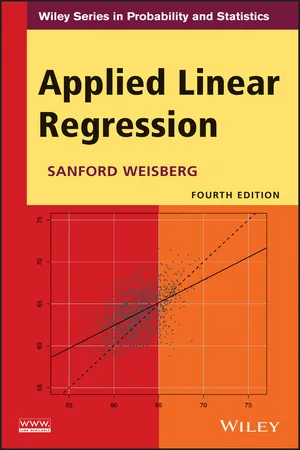
- English
- ePUB (mobile friendly)
- Available on iOS & Android
Applied Linear Regression
About this book
Praise for the Third Edition
"...this is an excellent book which could easily be used as a course text..."
—International Statistical Institute
The Fourth Edition of Applied Linear Regression provides a thorough update of the basic theory and methodology of linear regression modeling. Demonstrating the practical applications of linear regression analysis techniques, the Fourth Edition uses interesting, real-world exercises and examples.
Stressing central concepts such as model building, understanding parameters, assessing fit and reliability, and drawing conclusions, the new edition illustrates how to develop estimation, confidence, and testing procedures primarily through the use of least squares regression. While maintaining the accessible appeal of each previous edition,Applied Linear Regression, Fourth Edition features:
- Graphical methods stressed in the initial exploratory phase, analysis phase, and summarization phase of an analysis
- In-depth coverage of parameter estimates in both simple and complex models, transformations, and regression diagnostics
- Newly added material on topics including testing, ANOVA, and variance assumptions
- Updated methodology, such as bootstrapping, cross-validation binomial and Poisson regression, and modern model selection methods
Applied Linear Regression, Fourth Edition is an excellent textbook for upper-undergraduate and graduate-level students, as well as an appropriate reference guide for practitioners and applied statisticians in engineering, business administration, economics, and the social sciences.
Frequently asked questions
- Essential is ideal for learners and professionals who enjoy exploring a wide range of subjects. Access the Essential Library with 800,000+ trusted titles and best-sellers across business, personal growth, and the humanities. Includes unlimited reading time and Standard Read Aloud voice.
- Complete: Perfect for advanced learners and researchers needing full, unrestricted access. Unlock 1.4M+ books across hundreds of subjects, including academic and specialized titles. The Complete Plan also includes advanced features like Premium Read Aloud and Research Assistant.
Please note we cannot support devices running on iOS 13 and Android 7 or earlier. Learn more about using the app.
Information
- Are daughters taller than their mothers?
- Does changing class size affect success of students?
- Can we predict the time of the next eruption of Old Faithful Geyser from the length of the most recent eruption?
- Do changes in diet result in changes in cholesterol level, and if so, do the results depend on other characteristics such as age, sex, and amount of exercise?
- Do countries with higher per person income have lower birth rates than countries with lower income?
- Are highway design characteristics associated with highway accident rates? Can accident rates be lowered by changing design characteristics?
- Is water usage increasing over time?
- Do conservation easements on agricultural property lower land value?
1.1 Scatterplots
Inheritance of Height

Table of contents
- Cover
- Wiley Series in Probability and Statistics
- Title page
- Copyright page
- Dedication
- Preface to the Fourth Edition
- CHAPTER 1: Scatterplots and Regression
- CHAPTER 2: Simple Linear Regression
- CHAPTER 3: Multiple Regression
- CHAPTER 4: Interpretation of Main Effects
- CHAPTER 5: Complex Regressors
- CHAPTER 6: Testing and Analysis of Variance
- CHAPTER 7: Variances
- CHAPTER 8: Transformations
- CHAPTER 9: Regression Diagnostics
- CHAPTER 10: Variable Selection
- CHAPTER 11: Nonlinear Regression
- CHAPTER 12: Binomial and Poisson Regression
- Appendix
- References
- Author Index
- Subject Index